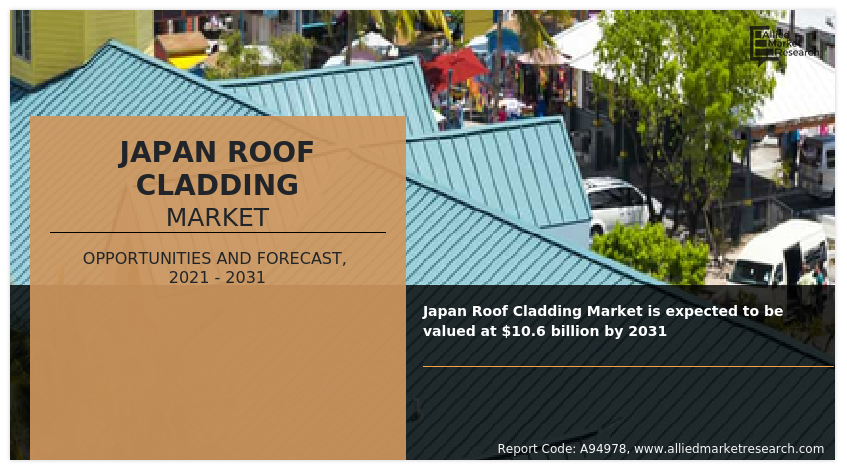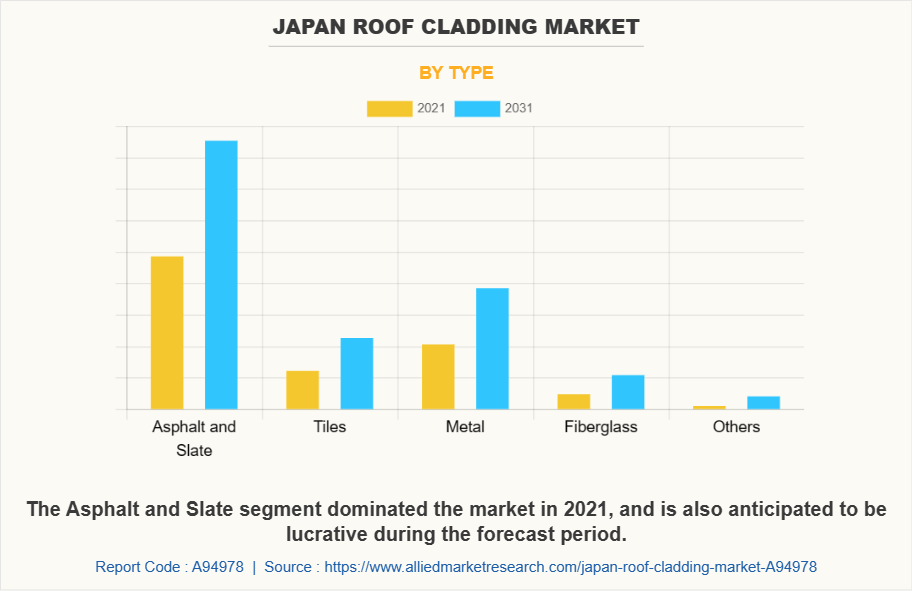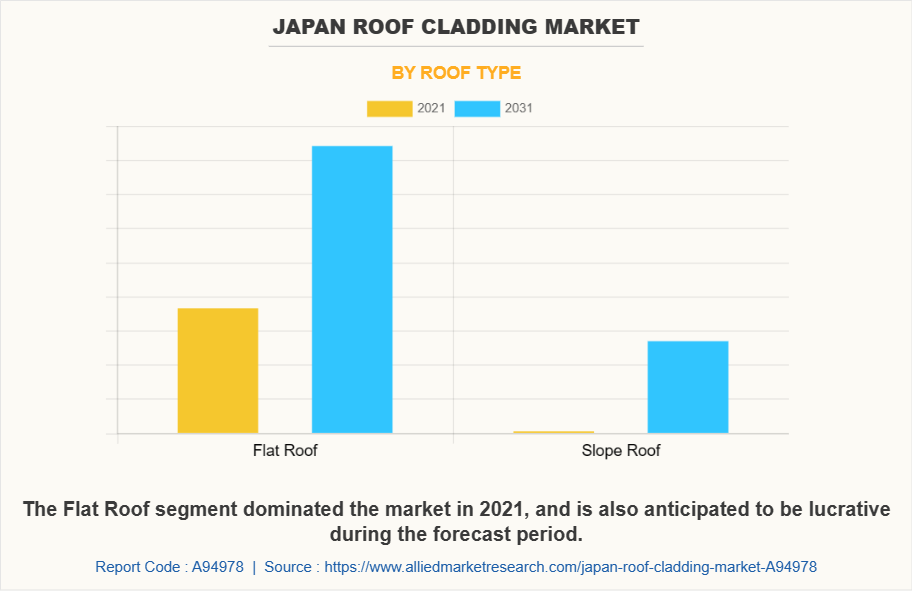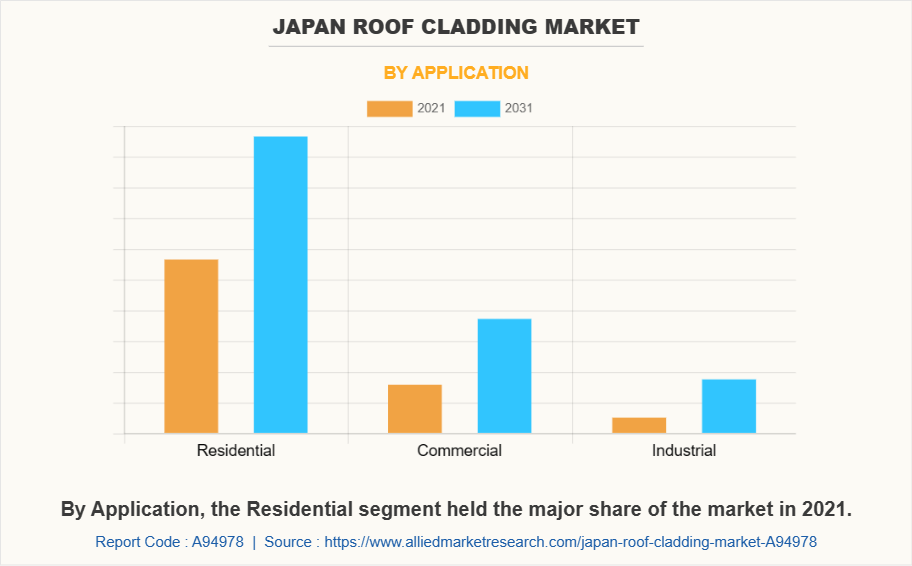The Japan roof cladding market has been witnessing significant growth during the forecast period, owing to increase in demand for durable and aesthetically pleasing roofing solutions. Moreover, surge in demand for innovative and visually appealing roof designs in modern architecture is a key factor driving the market growth. Furthermore, rise in need for energy-efficient roofing solutions is a key factor driving the market growth. In addition, rise in awareness of environmental concerns and energy conservation has surged the demand for sustainable & energy-efficient roof cladding materials.
Moreover, growth of construction industry in residential and commercial sectors is driving the market growth. Furthermore, increase in need for installation of high-quality roof cladding in new construction projects is driving the market growth.

However, high cost associated with certain types of roof cladding materials is a key factor restraining the market growth. In addition, environmental regulations and standards are the key factors restraining the growth of the Japan roof cladding market. Moreover, economic fluctuations are restraining the market growth.
On the contrary, evolving trends, consumer demands, and technological advancements are offering lucrative opportunities for market growth. Furthermore, growth of smart buildings and the integration of technology in construction projects open new avenues for market growth. In addition, smart roofing systems that monitor & regulate temperature, moisture levels, and energy consumption are gaining traction. In addition, rise in interest in sustainable & eco-friendly building practices has offered lucrative opportunities for the development of new and environmentally responsible roof cladding materials. Moreover, the integration of solar panels into roofing systems is a key trend driving the market growth.

The Japan roof cladding market is segmented into type, roof type, and application. On the basis of type, the market is classified into asphalt & slate, tiles, metal, fiberglass, and others. By roof type, it is bifurcated into flat roof and slope roof. As per application, it is categorized into residential, commercial, and industrial.
Furthermore, companies are investing in new product development and R&D to enhance the performance & sustainability of materials and develop new cladding solutions that offer improved insulation, longer lifespans, and reduced maintenance requirements. In addition, they are focusing on prioritizing consumer perceptions to cater to the ever-changing demands of the consumers. Moreover, they are implementing flexible pricing to accommodate a range of budgets, such as tiered pricing structures to cater to different market segments.

The Porter's five forces analysis assesses the competitive strength of the players in the Japan roof cladding market. These five forces include the bargaining power of suppliers, the bargaining power of buyers, the threat of new entrants, the threat of substitutes, and competitive rivalry. The bargaining power of suppliers is moderate. The bargaining power of buyers is high. The threat of new entrants is moderate. The threat of substitutes is low. The competitive rivalry is high.

A SWOT analysis of the Japan roof cladding market includes strengths, weaknesses, opportunities, and threats. The strengths include a diverse range of roof cladding materials, surge in demand for energy-efficient & sustainable solutions, and strong presence of established manufacturers with a track record of quality. The weaknesses include high initial costs associated with certain materials, vulnerability to economic fluctuations in the construction industry, and potential environmental regulations that impact manufacturing processes. The opportunities include integration of solar panels into roof cladding, innovation in sustainable & eco-friendly materials, and product diversification & cost reduction through R&D. The threats include intense market competition, the influence of economic downturns on construction activity, and stringent environmental regulations affecting materials & manufacturing processes.
The key players operating in the Japan roof cladding market include Nippon Steel Corporation, TOTO Ltd., Lixil Group Corporation, Panasonic Corporation, Sumitomo Metal Mining Co., Ltd., Kobe Steel, Ltd., NS Bluescope Coated Products, Nippon Light Metal Co., Ltd., Okasan Securities Group, Inc., and Maruichi Steel Tube Ltd.
Key Benefits For Stakeholders
- Enable informed decision-making process and offer market analysis based on the current market situation and estimated future trends.
- Analyze the key strategies adopted by major market players in Japan roof cladding market.
- Assess and rank the top factors that are expected to affect the growth of Japan roof cladding market.
- Top Player positioning provides a clear understanding of the present position of market players.
- Detailed analysis of the Japan roof cladding market segmentation assists to determine the prevailing market opportunities.
- Identify key investment pockets for various offerings in the market.
Japan Roof Cladding Market Report Highlights
| Aspects | Details |
| Forecast period | 2021 - 2031 |
| Report Pages | 87 |
| By Type |
|
| By Roof Type |
|
| By Application |
|
| Key Market Players | Nippon Steel Corporation, Daiseki Co., Ltd., SUMITOMO Corporation, Building Materials Corporation, Mitsui & Co., Ltd., Roofing Corporation, Mitsubishi Heavy Industries Repair & Maintenance Co., Ltd., Mitsubishi Corporation, Nichias Corporation, Yamaha Corporation |
The Japan Roof Cladding Market is estimated to reach $10.6 billion by 2031
Nichias Corporation, Mitsubishi Corporation, Mitsui & Co., Ltd., Nippon Steel Corporation, SUMITOMO Corporation, Roofing Corporation, Building Materials Corporation, Yamaha Corporation, Daiseki Co., Ltd., Mitsubishi Heavy Industries Repair & Maintenance Co., Ltd. are the leading players in Japan Roof Cladding Market
1. Enable informed decision-making process and offer market analysis based on current market situation and estimated future trends.
2. Analyze the key strategies adopted by major market players in japan roof cladding market.
3. Assess and rank the top factors that are expected to affect the growth of japan roof cladding market.
4. Top Player positioning provides a clear understanding of the present position of market players.
5. Detailed analysis of the japan roof cladding market segmentation assists to determine the prevailing market opportunities.
6. Identify key investment pockets for various offerings in the market.
Japan Roof Cladding Market is classified as by type, by roof type, by application
Loading Table Of Content...
Loading Research Methodology...



